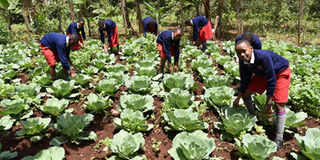Fertiliser use and how to spot fakes

Pupils of Pink Roses Academy in their school's farm in Ngewa, Kiambu County, where they farm bananas, sukuma wiki and yams for learning purposes and consumption. When applied on the farm, genuine fertilisers will lead to improvement of the soil health, your crops will grow vigorously and you will get the best harvest for higher profits. PHOTO | ANTHONY OMUYA | NMG
What you need to know:
- All the nutrients in our food originally come from the soil.
- Genuine fertiliser when applied to your farm will lead to improvement of the soil health, your crops will grow vigorously and you will get the best harvest for higher profits.
- Knowing when to fertilise is as important as using the right fertiliser.
- When you are buying a fertiliser, make sure the contents are listed on the bag with their percentages clearly labelled, for example, N:P:K 23:23:23.
It is that time of the year when farmers have prepared their farms and are ready to plant taking advantage of the rains. Every farmer normally hopes to get the best harvest at the end of the season.
However, the success of the crops depend on proper soil fertility management through the use of the right fertiliser.
Why add fertiliser to the soil?
All the nutrients in our food originally come from the soil. Soils naturally contain many nutrients like nitrogen, phosphorous and potassium.
But when the nutrients are missing or are in short supply, plants suffer from deficiency and do not grow well.
Once crops are harvested, the natural supply of nutrients in the soil must be re-filled, which is why it is important to add nutrients to the soils through the use of fertilisers.
Fertilisers contain nutrients such as nitrogen, phosphorus, and potassium and they are applied to supplement the elements for healthy crops.
How and when to use fertiliser
Genuine fertiliser when applied to your farm will lead to improvement of the soil health, your crops will grow vigorously and you will get the best harvest for higher profits. After getting the genuine fertiliser, how and when do you apply it?
Before adding fertiliser, you should send a soil sample to a laboratory for baseline testing. By testing soil, farmers know which nutrients are missing and how much to apply to the soil.
If too little is added, crops will not produce as much as they should. If too much is added, excess nutrients will run off the fields and pollute streams and groundwater.
So, while fertilisers serve an important purpose, farmers must be careful to use the right amount, at the right time.
When it comes to applying fertiliser, more does not mean better. Too much fertiliser can damage and maybe even kill your plants.
Be sure to check the label for the N-P-K ratio, as you may be able to use a general fertiliser with close to the same nutrient percentages but at a lower price.
Knowing when to fertilise is as important as using the right fertiliser. If you don’t apply the fertiliser at a time when the plant can use it, then all the fertiliser will go to waste.
For example, the most important time to apply super phosphates (TSP or SSP) or DAP is before planting. This is because phosphorus is critical for seedling root development and early growth.
Apply very soon before planting to ensure that fixation does not render the phosphate unusable by the time it is needed by seedlings.
Repeat the application of fertiliser as needed to maintain good plant growth. Using smaller amounts of fertiliser at frequent intervals may be more beneficial than applying at once at a higher rate.
How to spot fake fertiliser
Many farmers have claimed losses due to fake fertilisers sold to them. When you are buying a fertiliser, make sure the contents are listed on the bag with their percentages clearly labelled, for example, N:P:K 23:23:23.
Also check the packaging of the production batch number and seal. Also check the purity of the fertiliser you are buying.
One way of doing this is to look at the physical and some chemical properties. For example, DAP is hard, granular, brown or black in colour and does not break easily by nails. If some granules of DAP is heated slowly on a plate, it swells.
If it is super phosphate like TSP or SSP and it is hard, brown or black in colour and hard to crack by nails, there is a possibility that the fertiliser has been adulterated with DAP and NP fertilisers.
If it is heated, its granules do not swell whereas granules of DAP and other complexes swell. Urea is white, shinning and has consistent particle size and is round in shape.
It is completely soluble in water and one feels cold when the solution is touched. It also melts when kept on a hot plate. If the particle surface colour is too dark or reflective, then it was mixed with impurities.
The writer is based at Crops, Horticulture and Soils Department, Egerton University.




